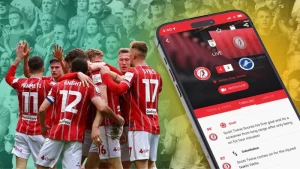Introduction
In today’s interconnected world, sports organizations face increasing pressure to create innovative ways to engage their fans. Digital Fan Engagement has become a crucial strategy for fostering deeper connections, building loyalty, and generating revenue. This article explores various strategies, their impact, and how they compare to traditional methods of fan engagement.
What is Digital Fan Engagement?

Digital fan engagement refers to using technology and online platforms to interact with fans, enhance their experiences, and keep them connected to their favorite sports teams and events. It includes tactics like social media interactions, virtual reality experiences, and personalized content delivery.
This method has evolved as fans demand more interactive and personalized ways to connect with their favorite teams, especially in a world where physical attendance isn’t always possible.
The Rise of Digital Fan Engagement
Digital fan engagement grew as fans started spending more time online. Social media, apps, and virtual experiences now play a huge part in how fans support their favorite teams. Instead of just watching games on TV or attending matches, fans can interact with players, join live events, and feel like part of the action from anywhere in the world.
The Role of Artificial Intelligence in Fan Engagement

Artificial intelligence (AI) is becoming an important tool in digital fan engagement. AI can analyze large amounts of data to predict what fans might like and create personalized experiences based on their preferences. For example, AI can recommend content, merchandise, or even tickets based on a fan’s previous activities. AI-powered chatbots are also being used to answer fan questions in real time, providing a quick and efficient way to engage with supporters. As AI technology improves, it will play an even bigger role in enhancing fan experiences and interactions.
Key Strategies for Digital Fan Engagement

1. Social Media Engagement
Platforms like Twitter, Instagram, and TikTok are vital for connecting with fans in real time. Teams share behind-the-scenes content, host live Q&A sessions, and create interactive polls to maintain a dynamic relationship with their fan base.
2. Mobile Applications
Team-specific mobile apps provide fans with live match updates, ticketing options, exclusive content, and gamified experiences like quizzes and predictions. These apps foster constant interaction, even during off-seasons.
3. Virtual and Augmented Reality (VR & AR)
Virtual reality experiences, such as immersive stadium tours or augmented reality filters during games, allow fans to feel closer to the action. These technologies transform passive spectators into active participants.
4. Personalization Through Data Analytics
Using data analytics, teams can offer personalized content, such as player highlights, merchandise suggestions, or match statistics tailored to individual preferences.
5. Esports and Gaming Partnerships
Collaborations with esports and gaming platforms help reach younger audiences. Teams can host virtual tournaments or include esports teams under their brand.
Benefits of Digital Fan Engagement

1. Enhanced Fan Loyalty
By maintaining consistent and meaningful interactions, teams build stronger emotional connections with their fans.
2. Increased Revenue Opportunities
Digital engagement opens new revenue streams, such as exclusive content subscriptions, digital merchandise, and sponsorship deals.
3. Broader Audience Reach
Digital platforms break geographical barriers, allowing fans worldwide to stay connected with their favorite teams.
Expanding Fan Interaction Through Social Media

Social media is one of the most powerful tools for engaging fans today. Platforms like Instagram, Twitter, and TikTok allow sports teams to reach their fans instantly. Teams can share behind-the-scenes content, live updates, and even host interactive sessions like Q&As. Fans enjoy being part of these real-time experiences and feel more connected to their favorite teams. By responding to comments and messages, teams show that they value their fans’ opinions and feedback, which helps build a loyal following.
Mobile Apps for Better Fan Experience

Sports teams have started using mobile apps to improve the fan experience. These apps make it easier for fans to stay updated with game scores, purchase tickets, and access exclusive content. Many apps now also offer features like live streaming, match previews, and player stats. Fans can use these apps to feel like they’re part of the action, even when they can’t attend games. Apps also help teams gather valuable data about fan preferences, which they can use to offer personalized content and advertisements.
Virtual Reality and Augmented Reality in Sports

Virtual Reality (VR) and Augmented Reality (AR) are becoming exciting ways for fans to engage with sports in a more immersive way. VR allows fans to experience games from the comfort of their homes, as if they were sitting courtside or at the stadium. AR, on the other hand, can enhance live matches by adding digital elements that fans can interact with using their smartphones. These technologies make watching sports more fun and give fans a new way to experience their favorite teams. While these technologies are still developing, they show great potential to reshape how fans enjoy sports.
The Growing Influence of Esports

Esports has become a major part of digital fan engagement. Many sports teams now have esports teams that compete in video game tournaments. These tournaments are often streamed online, and fans can watch their favorite players compete just like traditional sports events. By connecting with younger, tech-savvy audiences, teams can expand their fan base and bring in new generations of supporters. Esports also allows for global fan engagement, as fans from different countries can participate in online competitions or support their teams virtually.
Creating Long-Term Fan Engagement
The key to successful digital fan engagement is creating lasting connections with fans. Sports teams need to go beyond simply broadcasting games or posting on social media. They should provide valuable and consistent content that fans want to interact with. Whether it’s exclusive interviews, behind-the-scenes videos, or virtual meetups, offering fans something special keeps them engaged and loyal. By building a strong digital community, teams can keep fans excited about the sport, both in-season and off-season, ensuring their support for years to come.
Challenges in Implementing Digital Fan Engagement
While digital fan engagement offers many benefits, it also presents challenges, especially when it comes to reaching a global audience. Teams must create content that appeals to fans from different cultures and regions. They also need to consider language barriers, time zones, and varying levels of internet access. Additionally, global fan engagement requires consistent and reliable online platforms, which can be difficult to maintain. Despite these challenges, digital tools allow sports organizations to expand their reach and connect with fans all over the worl
1. High Initial Investment
Technologies like VR and AI require substantial investments, which might be challenging for smaller sports organizations.
2. Privacy Concerns
Collecting and using fan data for personalization can raise privacy issues. Ensuring compliance with data protection regulations is essential.
3. Maintaining Authenticity
Fans value genuine interactions. Over-commercialized or robotic engagements can alienate them.
The Future of Digital Fan Engagement

Looking ahead, digital fan engagement is expected to continue evolving with new technologies. Virtual reality (VR) and augmented reality (AR) are set to take fan engagement to the next level, allowing fans to experience games in ways never seen before. Fans might be able to attend virtual games or interact with 3D holograms of their favorite players.
Artificial intelligence will likely become more advanced, creating even more personalized experiences. With the rise of e-sports and mobile gaming, sports teams may also look for ways to engage fans in these digital spaces. As technology improves, the future of fan engagement will be more interactive, immersive, and connected than ever before.
Analysis Table: Digital Fan Engagement Strategies
| Strategy | Target Audience | Key Benefit | Challenges |
|---|---|---|---|
| Social Media Engagement | General fans, especially younger demographics | Real-time interaction and reach | Maintaining consistent quality |
| Mobile Applications | Tech-savvy fans | Centralized access to services | Development and maintenance cost |
| VR & AR | Tech enthusiasts | Immersive experiences | High cost of implementation |
| Personalization (Analytics) | All fans | Customized experiences | Privacy concerns |
| Esports Partnerships | Younger audience, gamers | Engages new demographics | Competitive and evolving market |
Comparative Table: Digital vs. Traditional Fan Engagement
| Aspect | Digital Engagement | Traditional Engagement |
|---|---|---|
| Accessibility | Global, 24/7 availability | Limited to events and broadcasts |
| Fan Interaction | Two-way, real-time | Mostly one-way communication |
| Cost | High initial setup, scalable | Recurring costs for events |
| Reach | Unlimited | Limited by geography |
| Customization | High, data-driven personalization | Low |
Conclusion
Digital fan engagement has revolutionized how sports organizations connect with their audiences. While challenges exist, the benefits of increased loyalty, broader reach, and revenue opportunities make it a worthwhile investment. Teams that effectively implement these strategies will not only remain relevant but thrive in the digital age.















